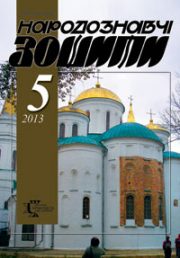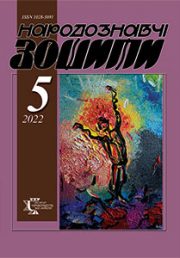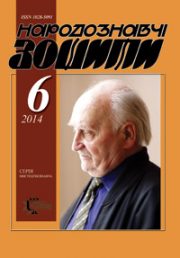The Ethnology Notebooks. 2019, № 5 (149), 1211—1219
UDK 398.88(=161.2)
DOI https://doi.org/10.15407/nz2019.05.1211
METAMORPHOSIS IN UKRAINIAN CAROLS WITH APOCRYPHAL MOTIFS
KACHMAR Maria
ORCID ID: https://orcid.org/0000-0002-7811-9576
candidate of Philological Sciences,
a researcher at the Institute of Ethnology
of the National Academy of Sciences of Ukraine,
15 Svobody Avenue, 79000, Lviv, Ukraine
e-mail: mariakachmar@ukr.net
Abstract. The article is devoted to the analysis of the principle of metamorphosis in Ukrainian carols with apocryphal motifs, which constitute the source base and object of the work. The purpose of the study is to unravel the meaning and function of the metamorphosis in these texts, the connection between the images of change, that codifies the experience of many generations, to find out the role and place of folk symbols. It is important, without a doubt, to consider the impact on the act of transforming people’s beliefs, Christian factors, moral and ethical norms, social realities and more. The article focuses on the main types of incarnation: the conversion of the tears of the Lord or other saint into a river, well, sea (metamorphosis of eminent character); the blood of the Savior into wine or the church; separate parts of Jesus’ body into different objects. The binary character of such changes in Ukrainian carols is indicated: mythological origin and later Christian influences. These include the motive of the appearance of rivers from human blood: blood — well — Danube — in the texts about the bathing of Christ and the dispute with the Apostle Peter. The semantics of water and fire as a matter of creation, often backed by the image of the world tree, is common in works about the transformation of sparks into three seas, the tear of the Lord into wheat. We trace the combination of Christian and pagan motifs in the texts about the change of the blood of Christ to the church and the tears to the wine. The sources of such metamorphosis may be the mythological notions as well as the biblical story about the conversion of water into wine in Cana of Galilee, the Christian doctrine of the church as the «Body of Jesus Christ». Metamorphosis of individual parts of the body of Jesus into different objects (thrones, candles, books, images, bells), despite Christian influences, is also of ancient origin. It is based on mythological beliefs about the emergence of individual parts of the world from the body of the first person. It is proved that the connection between incoming and outgoing images of change is regulated by folk symbols. Structural-semantic, structural-semiotic, textual, comparative, interdisciplinary methods, field research method were used to fulfill the purpose and tasks of the work.
Keywords: metamorphosis, carol, apocryphal motives, mythological consciousness, folk symbolism.
Received 28.09.2019
REFERENCES
Kyrchiv, R. (2010). The twentieth century in Ukrainian folklore. Lviv: Institute of Ethnology of the National Academy of Sciences of Ukraine [in Ukrainian].
Myshanych, S. (2003). Modern life of the Ukrainian folk ballad in the Carpathians. In Myshanych, S. Folklore and literary studies (Vol. 1, pp. 255—297). Donetsk: Donetsk National University [in Ukrainian].
Kostomarov, N. (1994). Slavic mythology. In Kostomarov, M. Slavic Mythology: Selected Works in Folklore and Literary Studies (pp. 201—252). Kyiv: Lybid [In Russian].
Hnatiuk, V. (1981). Some attention to the fable. In Notes of the Shevchenko Scientific Society. Hnatyuk, V. Selected articles on folk art: on the 110th anniversary of his birth (Vol. 201, pp. 185—205). New York [in Ukrainian].
Yaschurzhinskiy, Kh. (1991). On Transformations in malorusski fairy tales. In Ponomarov, A., & others (Eds.). Ukrainians: folk beliefs, beliefs, demonology (pp. 554—574). Kyiv: Lybid [in Russian].
Hrushevskyi, M. (1994). History of Ukrainian Literature: in 6 volumes, 9 books (Vol. 1; Vol. 4, B. 2). Kyiv: Lybid [in Ukrainian].
Kolessa, F. (1970). A ballad about a Bird-Daughter in Slavic folk poetry. In Kolessa, F. Folklore works (pp. 109—163). Kyiv: Naukova dumka [in Ukrainian].
Dei, O.I. (1988). Family ballads. In Dei, O. I. & others (Eds.). Ballads. Family relations (pp. 7—22). Kyiv: Naukova dumka [in Ukrainian].
Dunaievska, L.F. (1987). Ukrainian folk tale. Kyiv: High School [in Ukrainian].
Sokil, V.V. (1995). Folk legends and traditions of the Carpathian Ukrainians. Kyiv: Naukova dumka [in Ukrainian].
Eremina, V.I. (1991). Ritual and folklore. Leningrad: Science, Leningrad department [in Russian].
Kolessa, F. (1938). Ukrainian Oral Literature. Lviv [in Ukrainian].
Smirnovai N. Author’s interpretation of the reception of metamorphosis in the literature of the twentieth century (based on the works of F. Kafka, R. Bradbury, V. Zayets). Retrieved from: http://www.nbuv.gov.ua/…6/…/SmirnovaN.pdf.
Vinogradova, L.N. (1982). Winter calendar poetry of the western and eastern Slavs. Genesis and typology of carols. Moscow: Science [in Russian].
Franko, I. (1980). Causes to the history of Rus’ literature of the eighteenth century. In Franko, I. Collection of works: in 50 volumes (Vol. 27, pp. 16—23). Kyiv: Naukova Dumka [in Ukrainian].
Franko, I. (1899). Preface. In Franko, I. (Ed.). Apocrypha and legends from Ukrainian manuscripts (Vol. 2, pp. I—LXXVIII). Lviv [in Ukrainian].
Chubinskiy, P.P. (Ed.). (1872). Works of an ethnographic-statistical expedition to the West Russian Territory, equipped by the Imperial Russian Geographical Society. Southwestern Division (Vol. 1, 3). St. Petersburg [in Ukrainian].
Rybakov, B.F. (1987). Paganism of Ancient Rus. Moscow: Science [in Russian].
Hnatiuk, V. (Ed.). (1914). Christmas carols and generosity (Vol. 1). In Ethnographic collection (Vol. 35). Lviv [in Ukrainian].
Shukhevych, V. (Ed.). (1904). Hutsulshchyna (Vol. 4). In Materials to Ukrainian-Rus’ ethnology (Vol. 7). Lviv [in Ukrainian].
Vinogradova, L.N. (2009). River. In Tolstoy, N. I. (Ed.). Slavic antiquities: an ethnolinguistic dictionary (Vol. 4, pp. 416—419). Moscow: Mezhdunarodnyie otnosheniya [in Russian].
Sokil, V. (Ed.). (2003). Historical legends of Ukrainians. Lviv: M. Kots Publishing House [in Ukrainian].
Potebnya, A.A. (1887). Explanations of malorusski and related folk songs (Vol. 2). Warsaw [in Russian].
Krokhmalnyi, R.O. (2005). Metamorphosis and text: semantic, creative structure and ideological role of change of artistic image. Lviv [in Ukrainian].
Belova, O.V. (2004). Nikolay. In Tolstoy, N.I. (Ed.). Slavic antiquities: an ethnolinguistic dictionary (Vol. 3, pp. 398—401). Moscow: Mezhdunarodnyie otnosheniya [in Russian].
Sosenko, K. (1928). Cultural and historical figure of the old Ukrainian holidays of Christmas and the Generous Evening. Lviv [in Ukrainian].
Vinogradova, L.N., & Tolstoy, S.M. (2009). Dew. In Tolstoy, N.I. (Ed.). Slavic antiquities: an ethnolinguistic dictionary (Vol. 4, pp. 470—474). Moscow: Mezhdunarodnyie otnosheniya [in Russian].
Kliuka, V.B. (2006). Trees-symbols in carols: an attempt of semantic interpretation. Scientific visnyk (Issue 79—83) [in Ukrainian].
Valentsova, M.M., & Vinogradova, L.N. (1999). Well. In Tolstoy, N.I. (Ed.). Slavic antiquities: an ethnolinguistic dictionary (Vol. 2, pp. 536—541). Moscow: Mezhdunarodnyie otnosheniya [in Russian].
Zozulia, N. (2009). Jordan candles — «trinity». Folklore and ethnology, 4—5, 82—84 [in Ukrainian].
Belova, O.V. (1999). Blood. In Tolstoy, N.I. (Ed.). Slavic antiquities: an ethnolinguistic dictionary (Vol. 2, pp. 677—681). Moscow: Mezhdunarodnyie otnosheniya [in Russian].
Pylypchuk, S. (2010). The Christmas carol genre in the scientific reception of Ivan Franko. Visnyk of the Lviv university (Vol. 51, pp. 129—139). Lviv [in Ukrainian].
Toporov, V.N. (1982). The first person. In Tokarev, S.A. (Ed.). Myths of the world: encyclopedia (Vol. 2, pp. 300—302) [in Russian].
Franko, I. (Ed.). (2006). Apocrypha and legends from Ukrainian manuscripts (Vol. 1. The Old Testament Apocrypha: a preprint of the 1896 edition). Lviv: Ivan Franko National University of Lviv [in Ukrainian].






